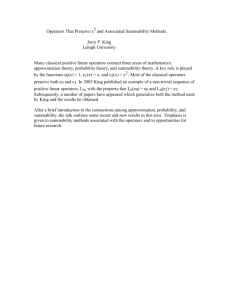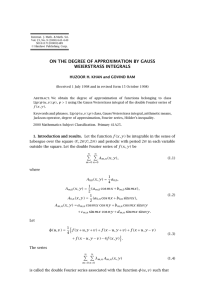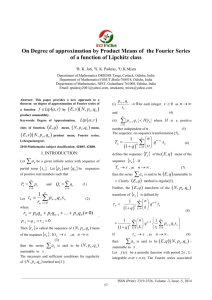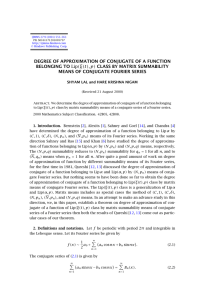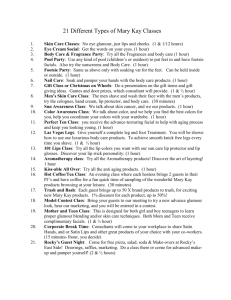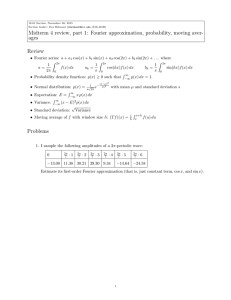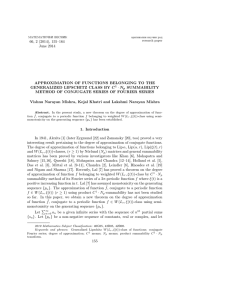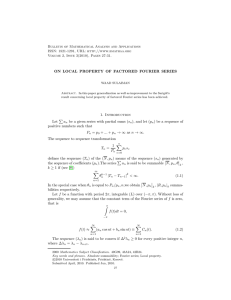Bulletin of Mathematical Analysis and Applications ISSN: 1821-1291, URL:
advertisement
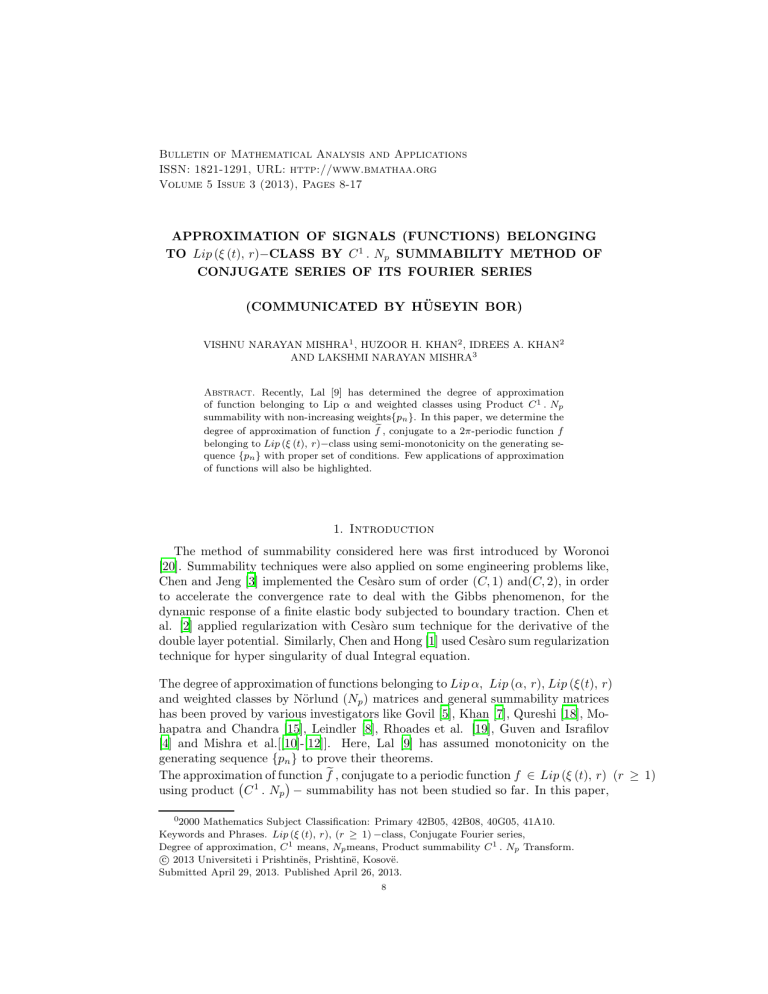
Bulletin of Mathematical Analysis and Applications
ISSN: 1821-1291, URL: http://www.bmathaa.org
Volume 5 Issue 3 (2013), Pages 8-17
APPROXIMATION OF SIGNALS (FUNCTIONS) BELONGING
TO Lip (ξ (t), r)−CLASS BY C 1 . Np SUMMABILITY METHOD OF
CONJUGATE SERIES OF ITS FOURIER SERIES
(COMMUNICATED BY HÜSEYIN BOR)
VISHNU NARAYAN MISHRA1 , HUZOOR H. KHAN2 , IDREES A. KHAN2
AND LAKSHMI NARAYAN MISHRA3
Abstract. Recently, Lal [9] has determined the degree of approximation
of function belonging to Lip α and weighted classes using Product C 1 . Np
summability with non-increasing weights{pn }. In this paper, we determine the
degree of approximation of function fe , conjugate to a 2π-periodic function f
belonging to Lip (ξ (t), r)−class using semi-monotonicity on the generating sequence {pn } with proper set of conditions. Few applications of approximation
of functions will also be highlighted.
1. Introduction
The method of summability considered here was first introduced by Woronoi
[20]. Summability techniques were also applied on some engineering problems like,
Chen and Jeng [3] implemented the Cesàro sum of order (C, 1) and(C, 2), in order
to accelerate the convergence rate to deal with the Gibbs phenomenon, for the
dynamic response of a finite elastic body subjected to boundary traction. Chen et
al. [2] applied regularization with Cesàro sum technique for the derivative of the
double layer potential. Similarly, Chen and Hong [1] used Cesàro sum regularization
technique for hyper singularity of dual Integral equation.
The degree of approximation of functions belonging to Lip α, Lip (α, r), Lip (ξ(t), r)
and weighted classes by Nörlund (Np ) matrices and general summability matrices
has been proved by various investigators like Govil [5], Khan [7], Qureshi [18], Mohapatra and Chandra [15], Leindler [8], Rhoades et al. [19], Guven and Israfilov
[4] and Mishra et al.[[10]-[12]]. Here, Lal [9] has assumed monotonicity on the
generating sequence {pn } to prove their theorems.
The approximation of function
fe , conjugate to a periodic function f ∈ Lip (ξ (t), r) (r ≥ 1)
1
using product C . Np − summability has not been studied so far. In this paper,
0
2000 Mathematics Subject Classification: Primary 42B05, 42B08, 40G05, 41A10.
Keywords and Phrases. Lip (ξ (t), r), (r ≥ 1) −class, Conjugate Fourier series,
Degree of approximation, C 1 means, Np means, Product summability C 1 . Np Transform.
c 2013 Universiteti i Prishtinës, Prishtinë, Kosovë.
Submitted April 29, 2013. Published April 26, 2013.
8
CLOSE-TO-CONVEXITY AND STARLIKENESS
9
we obtain a new theorem on the degree of approximation of function fe , conjugate
to a periodic function f ∈ Lip (ξ (t), r) (r ≥ 1) − class using semi-monotonicity
on the generating sequence {pn } and a proper set of the conditions.
P∞
Let n = 0 an be a given infinite series with the sequence of nth partial sums {sn }.
Let {pn } be a non-negative sequence of constants, real or complex, and let us write
Pn =
n
X
k= 0
pk 6= 0 ∀ n ≥ 0, p−1 = 0 = P−1 and Pn → ∞ asn → ∞ .
Pn
N
The sequence
ν = 0 p n − ν sν /Pn defines the
N to sequence transformation t n =
of
the
sequence
{s
} , generated by the sequence
sequence t n of Nörlund means
n
P∞
of coefficients {pn } . The series n = 0 an is said to be summable Np to the sum s
if lim t N
n exists and is equal to s. In the special case in which
n→ ∞
pn =
n+ α−1
α−1
=
(n + α)
; (α > −1) .
(n + 1) (α)
The Nörlund summability Np reduces to the familiar C α summability. The product
of C 1 summability with a Np summability defines C 1 . Np summability.
Pn
Pk
1
N
Pk−1 ν = 0 pk − ν sν . If
Thus the C 1 . Np mean is given by tC
= n+
n
k
=
0
1
P∞
N
tC
→ s as n → ∞ then the infinite series n = 0 an or the sequence {sn } is
n
N
said to be summable C 1 . Np to the sum s if lim tC
exists and is equal to s.
n
n→ ∞
P
n
−1
sn → s ⇒ Np (sn ) = tN
n = Pn
ν = 0 pn − ν sν → s, as n → ∞ , Np method
is regular,
N
⇒ C 1 (Np (sn ) ) = tC
→ s, as n → ∞ , C 1 method is regular, ⇒ C 1 . Np
n
method is regular.
Let L 2 π be the space of all 2 π- periodic and Lebesgue integrable functions over
[−π, π].
Then the Fourier series of f ∈ L 2 π at x is given by
f (x) ∼
∞
∞
X
a0 X
An (x)
(an cos x + bn sin n x) ≡
+
2
n=0
n=1
(1.1)
with nth partial sum sn (f ; x), where an and bn are the Fourier coefficients of f.
The conjugate series of Fourier series is given by
∞
X
(bn cos n x − an sin n x) ≡
n=1
∞
X
Bn (x) .
(1.2)
n=1
α
A function f (x) ∈ Lip α if | f (x + t) − f (x) | = O (| t| )
for 0 < α ≤ 1, t > 0 and
1/r
R
2π
=
f (x) ∈ Lip (α, r), [7] for 0 ≤ x ≤ 2π, if k f (x + t) − f (x) kr = 0 | f (x + t) − f (x) | r dx
α
O (|t| ) ,
0 < α ≤ 1, r ≥ 1, t > 0.
10
VISHNU NARAYAN MISHRA1 , HUZOOR H. KHAN2 , IDREES A. KHAN2 AND LAKSHMI NARAYAN MISHRA3
A signal f (x) ∈ Lip(ξ(t), r) if
Z 2π
1/r
k f (x + t) − f (x) k r =
|f (x + t) − f (x)| r dx
= O (ξ(t)) ,
0
r ≥ 1, t > 0.
If ξ(t) = tα then Lip (ξ(t), r) class coincides with the class Lip(α, r) and if r →
∞ then Lip(α, r) reduces to the class Lip α.
Thus, we observe that
ξ(t)=tα
r→∞
Lip(ξ(t), r) −→ Lip(α, r) −→ Lip α for 0 < α ≤ 1, r ≥ 1, t > 0.
L∞ - norm of a function f : R → R is defined by k f k∞ = sup {| f (x) | : x ∈ R} .
R
1/r
2π
r
Lr - norm of a function is defined by kf k r = 0 |f (x)| dx
, r ≥ 1.
The degree of approximation of a function f : R → R by trigonometric polynomial tn of order n under sup norm k k∞ is defined by ([21]) k tn − f k∞ =
sup {| tn (x) − f (x) | : x ∈ R} and En (f ) of a function f ∈ L r is given by
En (f ) = min k tn − f k r . The conjugate function fe(x) is defined for almost evn
ery x by
Z π
Z π
1
1
ψ (t) cot t/2 dt = lim −
ψ (t) cot t/2 dt .
fe(x) = −
h→0
2π 0
2π h
CN
We note that t N
are also trigonometric polynomials of degree (or order)
n and tn
n.
Abel’s Transformation: The formula
n
X
uk vk =
k=m
n
−1
X
k=m
Uk (vk − vk + 1 ) − Um − 1 vm + Un vn ,
(1.3)
where 0 ≤ m ≤ n, Uk = u0 + u1 + u2 + ....+ uk , if k ≥ 0, U− 1 = 0, which can
be verified, is known as Abel’s transformation and will be used extensively in what
follows. If vm , vm + 1 , ..., vn are non-negative and non-increasing, the left hand side
of (1.3) does not exceed 2 vm
max
| Uk | in absolute value. In fact,
m−1 ≤ k ≤ n
n
X
uk vk
k=m
≤ max | Uk |
( n−1
X
k=m
(vk − vk + 1 ) + vm + vn
)
= 2 vm max | Uk | .
(1.4)
We write throughout φ (t) = f (x + t) − 2 f (x) + f (x − t) ,
Wn =
n
k
X
X
1
Pk−1
(ν + 1) | pν − pν −1 | ,
2 π (n + 1)
ν=0
k=0
J˜ (n, t) =
n
k
X
X
cos (k − v + 1/2) t
1
−1
Pk
pν
2 π (n + 1)
sin t/2
ν =0
(1.5)
k=0
τ = [1/t] , where τ denotes the greatest integer not exceeding 1/t. Furthermore, C
denotes an absolute positive constant, not necessarily the same at each occurrence.
CLOSE-TO-CONVEXITY AND STARLIKENESS
11
2. Main Theorem
It is well known that the theory of approximations i.e., TFA, which originated from
a well-known theorem of Weierstrass, has become an exciting interdisciplinary field
of study for the last 130 years. These approximations have assumed important
new dimensions due to their wide applications in signal analysis [16], in general
and in Digital Signal Processing [17] in particular, in view of the classical Shannon
sampling theorem. Mittal et. al.
([[13], [14]]) have obtained many interesting results on TFA using summability
methods without monotonicity on the rows of the matrix T: a digital filter.
Broadly speaking, signals are treated as functions of one variable and images are
represented by functions of two variables. But till now, nothing seems to have been
done so far to obtain the degree of approximation of conjugate of a function using
C 1 . Np product summability method of its conjugate series of Fourier series.
Therefore, the purpose of present paper is to establish a quite new theorem on
degree of approximation of a function f˜ (x) , conjugate to a 2π− periodic function
f belonging to Lip (ξ(t), r), (r ≥ 1)− class by C 1 . Np means of conjugate series
of Fourier series using semi-monotonicity on the generating sequence {pn }and a
proper set of conditions. We prove
Theorem 2.1. If f˜ (x) ,conjugate to a 2π − periodic function f belonging to Lip (ξ(t), r)
class, then its degree of approximation by C 1 . Np means of conjugate series of
Fourier series (1.2) is given by
1
1/2 r
N
e
√
,
(2.1)
t̃C
−
f
=
O
(n)
ξ
n
n
r
provided {pn } satisfies the
(2.2)
Wn < C,
and ξ (t) satisfies the following conditions: {ξ (t)/t} is non-increasing in
′ ′
(2.3)
t ,
r
Z π/√ n | ψ (t) |
ξ (t)
0
Z
π
√
π/ n
t−δ | ψ (t) |
ξ (t)
r
dt
dt
!1/r
!1/r
= O (1) ,
=O
√ δ
,
n
(2.4)
(2.5)
where δ is an arbitrary number such that s (1 − δ) − 1 > 0, r−1 + s−1 = 1, 1 ≤ r ≤
∞, conditions (2.4) and (2.5) hold uniformly in x.
Note 2.2. ξ √πn ≤ π ξ √1n , for √πn ≥ √1n .
Note 2.3. Condition Wn < C ⇒ n pn < C Pn , ([6]).
Note 2.4. The product transform C 1 . Np plays an important role in signal theory
as a double digital filter [10] and theory of Machines in Mechanical Engineering
[10].
12
VISHNU NARAYAN MISHRA1 , HUZOOR H. KHAN2 , IDREES A. KHAN2 AND LAKSHMI NARAYAN MISHRA3
We need the following lemmas for the proof of our theorem:
Lemma 3.1.
√
J˜ (n, t) = O [1/t] for 0 < t ≤ π/ n.
Proof. For 0 < t ≤ π/
√
J˜ (n, t) =
n, sin (t/2) ≥ (t/π) and | cos nt | ≤ 1.
n
k
X
X
1
cos (k − v + 1/2) t
P −1
pν
k
2 π (n + 1)
sin t/2
v =0
k=0
≤
n
k
X
X
|cos (k − v + 1/2) t|
1
P −1
pν
k
2 π (n + 1)
|sin t/2|
v =0
k=0
Pn
−1 Pk
≤ 2 t (n1 + 1)
k=0 P k
v = 0 pν
P
n
−1
= 2 t (n1 + 1)
P
P
k
k=0
k
= O [τ ] .
This completes the proof of Lemma 3.1.
Lemma 3.2. Let {pn } be a non-negative sequence and satisfies (3.2), then
2 P
n
−1 P k− 1
|∆
p
|
uniformly in
P
J˜ (n, t) = O (τ ) + O τn
ν
ν= 0
k=τ
k
0 < t ≤ π.
(3.1)
Proof. We have
J˜ (n, t) =
n
X
1
P
2 π (n + 1)
=
1
2 π (n + 1)
τX
−1
+
k=0
n
X
k=τ
pν
v =0
k=0
!
k
X
−1
k
P
−1
k
k
X
cos (k − v + 1/2) t
sin t/2
pν
v =0
cos (k − v + 1/2) t
sin t/2
= J˜1 (n, t) + J˜2 (n, t) ,
(3.2)
say,
where
J˜1 (n, t) =
τX
−1
1
P
2 π (n + 1)
k=0
J˜2 (n, t) =
−1
k
k
X
k
X
v =0
pν
cos (k − v + 1/2) t
sin t/2
τX
−1
k
X
1
|cos (k − v + 1/2) t|
≤
P −1
pν
k
|sin t/2|
2 t (n + 1)
v =0
v =0
k=0
k=0
τ2
,
(3.3)
=O
(n + 1)
and using Abel’s transformation and sin (t/2) ≥ (t/π) , for 0 < t ≤ π, we get
≤
τX
−1
1
P
2 π (n + 1)
−1
k
pν
n
k
X
X
1
cos (k − v + 1/2) t
P −1
pν
k
2 π (n + 1)
sin t/2
v =0
k=τ
CLOSE-TO-CONVEXITY AND STARLIKENESS
n
X
1
P
≤
2 t (n + 1)
−1
k
v =0
k=τ
+
(k−1
X
k
X
γ =0
ν
X
|∆ pν |
γ =0
cos (k − γ + 1/2) t
!
cos (k − γ + 1/2) t
pk
13
!
)
!
n
kX
−1
n
X
X
O t−1
−1
−1
P k pk
|∆ pν | +
P k
=
2 t (n + 1)
v =0
k=τ
k=τ
Pµ
by virtue of the fact that k = λ exp (−ikt) = O t−1 , 0 ≤ λ ≤ k ≤ µ.
!
X
n
kX
−1
n
X
τ2
k
−1
−1
˜
J2 (n, t) = O
P k
|∆ pν | +
P k pk
(n + 1)
k
v =0
k=τ
k=τ
!
X
kX
−1
n
τ2
(n + 1)
−1
=O
P k
|∆ pν | +
(n + 1)
τ
v =0
k=τ
X
n
kX
−1
τ2
−1
P k
|∆ pν | ,
= O (τ ) + O
(n + 1)
v =0
k=τ
J˜2 (n, t) = O (τ ) + O
2
τ
n
X
n
P
k=τ
−1
k
kX
−1
v =0
|∆ pν |
(3.4)
in view of note 2.3. Combining (3.2), (3.3) and (3.4) yields (3.1).
This completes the proof of Lemma 3.2.
Proof of Theorem 2.1: Let s̃n (f ; x) denotes the partial sum of series (1.2), we
have
Z π
1
cos (n + 1/2) t
˜
s̃n (f ; x) − f (x) =
dt.
ψ (t)
2π 0
sin t/2
CN
Denoting C 1 . Np means of sf
n (f ; x) by t̃n , we write
Z π
n
k
X
X
1
cos (k − v + 1/2) t
−1
N
˜ (x) =
ψ
(t)
t̃C
(x)
−
f
dt
P
pν
n
k
2 π (n + 1)
sin t/2
0
ν =0
k=0
"Z
#
√
Z π
Z π
π/ n
=
ψ (t) J˜ (n, t) dt =
+
ψ (t) J˜ (n, t) dt
√
0
0
π/ n
= I1 + I2 (say).
(4.1)
Clearly, |ψ (x + t) − ψ (t)| ≤ |f (u + x + t) − f (u + x)| + |f (u − x − t) − f (u − x)| .
Hence, by Minkowski’s inequality,
Z 2 π
1 / r
Z 2 π
1 / r
r
r
|(ψ (x + t) − ψ (t)) | dx
≤
|(f (u + x + t) − f (u + x)) | dx
0
0
+
Z
0
2π
1 / r
|(f (u − x − t) − f (u − x)) | dx
= O (ξ (t)) .
r
14
VISHNU NARAYAN MISHRA1 , HUZOOR H. KHAN2 , IDREES A. KHAN2 AND LAKSHMI NARAYAN MISHRA3
Then f ∈ Lip (ξ (t) , r) ⇒ ψ ∈ Lip (ξ (t) , r) . Using Hlder’s Inequality, ψ (t) ∈
Lip (ξ (t) , r) , condition (2.4) , sin (t/2) ≥ (t/π) , for 0 < t ≤ π, Lemma 3.1, note
2.2 and Second Mean Value Theorem for integrals, we have
"Z
#1/s
√
r #1/r "Z π /√ n π/ n s
| ψ(t) |
˜ t)
|I1 | ≤
dt
ξ(t) J(n,
dt
ξ(t)
0
0
= O (1)
"Z
π/
√
n
0
ξ(t)
t
s
dt
#1/s
"Z π /√ n s #1 / s
1
π
dt
=O ξ √
, as h → 0
n
t
h
1
r/2
= O (n)
ξ √
, r−1 + s−1 = 1.
n
(4.2)
Using Lemma 3.2, we have
|I2 | = O
"Z
π
π/
√
n
|ψ (t) |
dt
t
#
+O
"Z
π
√
π/ n
|ψ (t) |
tn
τ
n
X
P k−1
k−
X1
ν= 0
k=τ
| pν |
!
dt
#
= O (I2 1 ) + O (I2 2 ) .
Using Hlder’s Inequality, conditions (2.3) and (2.5), note 2.2 and Second Mean
Value Theorem for integrals, we have
"Z
−δ
r #1 /r "Z π
s #1 / s
π
t | ψ (t) |
ξ(t)
|I2 1 | ≤
dt
dt
√
√
ξ(t)
t− δ + 1
π/ n
π/ n
"
√ Z
δ
=O
n
π
√
π/
n
ξ(t)
t−δ + 1
s
dt
#1/s
n √ o Z
δ
=O
n
√
n/π
1/π
1/s
s
ξ 1/y
dy
y δ−1
y2
"
#1 / s
Z √n/π π/√
ξ
√ δ
n
dy
= O n
π/√
yδs+2
1/π
n
=O
!
√ −δ s−1
δ s +1 1 / s
− (π)
1
( n)
√
−δ s − 1
n
1
r/2
.
= O (n)
ξ √
n
√ δ+1
n
ξ
(4.3)
Similarly, as above conditions (2.2), (2.3), (2.5), note 2.2 and Second Mean Value
Theorem for integrals, we have
"Z
−δ
r #1 / r
π
t | ψ (t) |
|I2 2 | ≤
dt
√
ξ(t)
π/ n
CLOSE-TO-CONVEXITY AND STARLIKENESS
"Z
π
π/
=O
=O
=O
1
n
ξ(t)
√
n
t− δ + 1
√ δ ! "Z π
( n)
√
n
π/ n
√ δ ! "Z π
( n)
√
n
π/ n
√ δ ! "Z π
( n)
√
n
π/ n
=O
n
X
τ
| pν |
n
X
P k−1
k−
X1
n
X
P k−1
k−
X1
n
X
P k−1
ν= 0
k=τ
ξ(t)
τ
t−δ + 1
ξ(t)
t−δ + 1
ν= 0
k=τ
ν= 0
k=τ
ξ(t)
t−δ + 1
!! s
k−
X1
P k−1
k
X
ν= 0
k=0
| pν |
15
dt
#1/s
!!s
(ν + 1) | pν |
(ν + 1) | pν |
dt
#1 / s
!!s
!!s
dt
dt
#1 / s
#1 / s
s #1 / s
√ δ ! "Z π
( n)
ξ(t)
Wn 2 π (n)
dt
√
n
t−δ + 1
π/ n
"
√ Z
δ
n
=O
π/
n √ o Z
δ
n
=O
π
√
√
n
n/ π
1/π
ξ(t)
t−δ + 1
s
dt
#1 / s
1 / s
s
ξ 1/y
dy
y δ−1
y2
1
r/2
= O (n)
ξ √
.
n
(4.4)
Collecting (4.1)-(4.4), we have
N
e = O (n) r / 2 ξ √1
.
t̃C
−
f
n
n
Now, using the L r -norm of a function, we get
nR
o1 / r
r
2π
N
=
t̃C
(x) − fe (x) dx
n
0
r
R r 1 / r
2π
=O 0
(n) r / 2 ξ √1n
dx
N
t̃C
− fe
n
r/2
= O (n )
=O
ξ
1
√
n
r/2
(n )
This completes the proof of Theorem 2.1.
Z
ξ
2π
dx
0
1
√
n
1 / r !
.
(4.5)
16
VISHNU NARAYAN MISHRA1 , HUZOOR H. KHAN2 , IDREES A. KHAN2 AND LAKSHMI NARAYAN MISHRA3
3. Applications
Some interesting applications of the Cesàro summability can be seen [[1], [2], [3]].
The following corollaries can be derived from Theorem 2.1.
Corollary 5.1. If ξ(t) = tα , 0 < α ≤ 1, then the class Lip (ξ(t), r) , r ≥ 1,
reduces to the class Lip (α, r) , r1 < α < 1 and the degree of approximation of
a function fe(x), conjugate to a 2π− periodic function f belonging to the class
Lip (α, r) , is given by
−α / 2 + 1 / 2 r
N
.
(5.1)
t̃C
− fe = O (n)
n
Proof. Putting ξ(t) = tα , 0 < α ≤ 1 in Theorem 2.1, we have
N
t̃C
− fe
n
r
Z
=
2π
0
≤
r
dx
1 / r
=O
= O (n) −α / 2 + r / 2 .
Thus we get
N
t̃C
− fe
n
N
t̃C
(x) − fe (x)
n
Z
0
2π
N
t̃C
(x) − fe (x)
n
r
(n)
r /2
ξ 1
√ n
1 / r
−α / 2 + r / 2
dx
, r ≥ 1.
= O (n )
This completes the proof of corollary 5.1.
Corollary 5.2. If ξ (t) = tα for 0 < α < 1and r → ∞ in (5.1), then f ∈ Lip α. In
this case, using (5.1), we have
−α / 2
N
.
(5.2)
fe(x) − t̃C
(x)
=
O
(n)
n
∞
Proof. For r → ∞, we get
N
fe(x) − t̃C
n (x)
∞
=
sup
0 ≤ x ≤ 2π
N
fe(x) − t̃C
n (x)
r
= O (n)−α / 2 .
This completes the proof of corollary 5.2.
4. Conclusion
Various results concerning to the degree of approximation of periodic signals (functions) belonging to the Lip (ξ(t), r), (r = 1)-class by Matrix Operator have been
reviewed and the condition of monotonicity on the weights {pn } has been relaxed
(i.e. weakening the conditions on the filter, we improve the quality of digital filter). Further, a proper (correct) set of conditions have been discussed to rectify the
errors. Some interesting application of the operator (C1 . Np ) used in this paper
pointed out in Note 2.4.
CLOSE-TO-CONVEXITY AND STARLIKENESS
17
References
[1] J.T. Chen and H.K. Hong, Review of dual boundary element methods with
emphasis on hypersingular integrals and divergent series, Applied Mechanics
Reviews, ASME, 52 (1999) 17-33.
[2] J.T. Chen, H.K. Hong, C.S. Yeh, and S.W. Chyuan, Integral representations
and regularizations for a divergent series solution of a beam subjected to support
motions, Earthquake Engineering and Structural Dynamics 25 (1996) 909-925.
[3] J.T. Chen and Y.S. Jeng, Dual Series Representation and Its Applications to
a String Subjected to Support Motions, Advances in Engineering Software 27
(1996) 227-238.
[4] A. Guven, D.M. Israfilov, Trigonometric Approximation in Generalized
Lebesgue Space Lp(x) , J. Math. Inequ. 4 (2010) 285-299.
[5] N.K. Govil, On the Summability of a Class of the Derived Conjugate Series of
a Fourier series, Canadian Mathematical Bulletin 8 (1965) 637-645.
[6] E. Hille, J.D. Tamarkin, On the summability of Fourier series. I, Trans. of the
Amer. Math. Soc. 34 (1932) 757-783.
[7] Huzoor. H. Khan, On the degree of approximation of a functions belonging to
the class Lip(α, p), Indian J. Pure Appl. Math. 5 (1974) 132-136.
[8] L. Leindler, Trigonometric approximation in Lp - norm, J. Math. Appl. 302
(2005) 129-136.
[9] S. Lal, Approximation of functions belonging to the generalized Lipschitz class
by C 1 . Np summability method of Fourier series, Appl. Math. Comp. 209 (2009)
346-350.
[10] V.N. Mishra, Kejal Khatri and L.N. Mishra, Product Summability Transform
of Conjugate series of Fourier series, Int. J. Math. Math. Sci. Article ID 298923
(2012) 13 pages, doi: 10.1155/2012/298923.
[11] V.N. Mishra, K. Khatri, L.N. Mishra, Product (N, pn ) (C, 1) summability of
a sequence of Fourier coefficients, Math. Sci. (Springer open access) 2012, 6:38,
DOI: 10.1186/2251 7456-6-38.
[12] V.N. Mishra, K. Khatri, L.N. Mishra, Using Linear Operators to Approximate
Signals of Lip (α , p), (p ≥ 1)-Class, accepted (Filomat) 2012.
[13] M.L. Mittal, B.E. Rhoades, V.N. Mishra, U. Singh, Using infinite matrices to
approximate functions of class Lip (α , p) using trigonometric polynomials, J.
Math. Anal. Appl. 326 (2007) 667-676.
[14] M.L. Mittal, B.E. Rhoades, V.N. Mishra, Approximation of signals (functions)
belonging to the weighted W (LP , ξ(t), (p ≥ 1)−Class by linear operators, Int.
J. Math. Math. Sci. ID 53538 (2006) 1-10.
[15] R.N. Mohapatra and P. Chandra, Degree of Approximation of Functions in
the Holder Metric, Acta Math. Hungar. 41 (1983) 67-76.
[16] J.G. Proakis, Digital Communications, Mc Graw-Hill, New York, 1985.
[17] E.Z. Psarakis, G.V. Moustakides, An L2 – based method for the design of 1-D
zero phase FIR digital filters, IEEE Trans. Circuits Syst. I. Fundamental Theor.
Appl. 44 (1997) 591 -601.
[18] K. Qureshi, On the degree of approximation of functions belonging to the
Lipschitz class by means of a conjugate series, Indian J. Pure Appl. Math. 12
(1981) 1120-1123.
[19] B.E. Rhoades, K. Ozkoklu, I. Albayrak, On degree of approximation to a
functions belonging to the class Lipschitz class by Hausdroff means of its Fourier
18
VISHNU NARAYAN MISHRA1 , HUZOOR H. KHAN2 , IDREES A. KHAN2 AND LAKSHMI NARAYAN MISHRA3
series, Appl. Math. Comp. 217 (2011) 6868-6871.
[20] G.F. Woronoi, Extension of the notion of the limit of the sum of terms of an
infinite series, Annals of Math., 33 (1932) 422-428.
[21] A. Zygmund, Trigonometric series, 2nd ed., Vol. 1, Cambridge Univ. Press,
Cambridge, 1959 pp. 114-115.I. S. Jack, Functions starlike and convex of order
alpha, J. London Math. Soc. 3(2)(1971), 469-474.
1 Department
of Applied Mathematics and Humanities, Sardar Vallabhbhai National
Institute of Technology, Ichchhanath Mahadev Road, Surat, Surat-395 007 (Gujarat),
India
E-mail address: vishnunarayanmishra@gmail.com
2 Department
of Mathematics,, Aligarh Muslim University, Aligarh - 202002, India
E-mail address: huzoorkhan@yahoo.com
E-mail address: idrees maths@yahoo.com
3 L.
1627 Awadh Puri Colony Beniganj, Phase-III, Opp.- I.T.I., Ayodhya Main Road, Faizabad -224 001 (Uttar Pradesh), India
E-mail address: lakshminarayanmishra04@gmail.com
